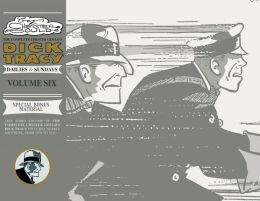
Thank God for IDW Publishing! With Gemstone once again having fallen silent -- let us hope that the struggling company hasn't finally begun to "flatline" -- the fecund comics-reprint house has become one of my primary sources for comics-review fodder. LITTLE ORPHAN ANNIE Volume 3 is just around the corner, with an announced release date of March 1. Between LOA, DICK TRACY, Fantagraphics' THE COMPLETE PEANUTS, and Dark Horse's ongoing Harvey Comics reprint project, my trips to the comics shop may become less frequent in the absence of Gemstone releases, but they'll yield prime merchandise.
The latest TRACY volume opens with "Unholy Matrimony," unquestionably my least favorite Gould continuity (of those of which I'm aware, of course). Like the other continuities in this volume, I'd previously read the tale of Tess Trueheart's thwarted tie with batty ex-big-leaguer Edward Nuremoh in a Pacific Comic Club collection. I panned it when I reviewed it the first time, and, trust me, it hasn't improved on reacquaintance. Before "Matrimony" (as Max Allan Collins points out in his introduction to Volume 6), Gould hadn't used Tess in a major story in quite some time, so it made sense to train the spotlight on her -- but NOT in a melodramatic mishmosh that Jay Maeder accurately describes as "loony" and even Collins admits is "at times, ridiculously over the top." What's more, once Nuremoh's suicide has literally driven the traumatized Tess crazy, the poor girl remains in that state for an additional agonizing month, stumbling into a brief partnership with a crook who deals in stolen dogs (and I thought Nuremoh was a cad!). The whole mess ends with Tracy clearing Tess of a murder rap and the babe herself sprawled in a self-abasing position at her no-longer-ex-boyfriend's feet. And just think, the two still wouldn't get married for another decade.
Getting the Nuremoh nonsense out of his system appears to have caused Gould to do a major rethink. After restoring some manner of equilibrium with a brief and rather unmemorable continuity involving a crooked fur dealer, Gould brings back one of his strongest early villains, Stooge Viller, for a last bow. Yes, more melodrama ensues as Viller (who, predictably, refuses to reform, preferring to become a supplier to the underworld) desperately seeks to reconnect with his alienated daughter Binnie -- who inadvertently helps bring about Stooge's finish -- but tidying up this particular loose end appears to have cleared Gould's mind and reminded him where his strengths lay: in the depiction of strong criminal opponents for Tracy. Shortly after Viller's fall, midget crime boss Jerome Trohs and his obscenely fat and unnaturally strong "moll" Mamma (see, Joe, it didn't start with Little Lotta!) appear on the scene, presaging the onrushing era of classic Tracy grotesques. Trohs himself isn't exactly a grotesque -- apart from his size and his Harold Gray-style blank eyeballs, he's basically a conventional mobster -- but his use appears to have struck a spark of newfound creativity. It's significant that two of Tracy's next three foes are Yogee Yamma, a tricked-up mystical fakir, and Deafy, a dealer in stolen bicycle parts whose supposed handicap -- like The Blank, whose blank face was only a cheesecloth covering, Deafy hears just fine despite the hearing aid in his ear -- gives him his name. In between those encounters, Black Pearl, a vaguely sinister arms dealer, hints at the coming war and its own contributions to the Tracy "universe," such as enemy agents Pruneface and The Brow.
Regarding artwork, Collins correctly notes that 1940 sees the appearance of the "glossier, simpler, [and] stronger" art style that will carry TRACY through the war years and beyond. Actually, I'd date the first hints of this new, slicker style to the Jerome Trohs story, rather than the Yogee Yamma continuity. What happened here, I think, was the final disappearance of the Dick Moores influence that dated back to the mid-1930s. Moores' style of lettering stayed intact, but the elaborate, busy backgrounds that Moores designed for TRACY (and which can also be seen in JIM HARDY, his first syndicated strip) are somewhat simplified and scaled back, letting the characters in the foregrounds stand out more effectively. TRACY would never be the best-drawn adventure strip, but it was well on its way to becoming the most visually distinctive, save perhaps LITTLE ORPHAN ANNIE. (Speaking of which, guess whose likeness in doll form can be seen in Binnie's bed in the strip of 12/28/39?)
No comments:
Post a Comment